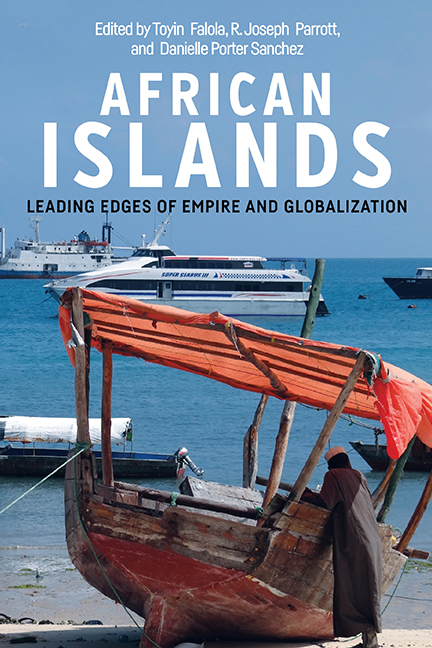Book contents
- Frontmatter
- Dedication
- Contents
- Introduction: Arbiters and Witnesses of Change: Contextualizing Conversations on African Islands
- Part 1 Atlantic Ocean Islands
- Part 2 Indian Ocean Islands
- 8 Africa's Indian Ocean Islands, Near and Distant
- 9 Monsoon Metropolis: Migration, Mobility, and Mediation in the Western Indian Ocean
- 10 The Mascarenes, Indian Ocean Africa, and Global Labor Migration during the Eighteenth and Nineteenth Centuries
- 11 The Island as Nexus: Zanzibar in the Nineteenth Century
- 12 Slavery and Postslavery in Madagascar: An Overview
- 13 The Comoros: Strategies of Islandness in the Indian Ocean
- 14 Gendered Pioneers from Mayotte: An Ethnographic Perspective on Travel and Transformation in the Western Indian Ocean
- Notes on Contributors
- Index
8 - Africa's Indian Ocean Islands, Near and Distant
from Part 2 - Indian Ocean Islands
Published online by Cambridge University Press: 31 August 2019
- Frontmatter
- Dedication
- Contents
- Introduction: Arbiters and Witnesses of Change: Contextualizing Conversations on African Islands
- Part 1 Atlantic Ocean Islands
- Part 2 Indian Ocean Islands
- 8 Africa's Indian Ocean Islands, Near and Distant
- 9 Monsoon Metropolis: Migration, Mobility, and Mediation in the Western Indian Ocean
- 10 The Mascarenes, Indian Ocean Africa, and Global Labor Migration during the Eighteenth and Nineteenth Centuries
- 11 The Island as Nexus: Zanzibar in the Nineteenth Century
- 12 Slavery and Postslavery in Madagascar: An Overview
- 13 The Comoros: Strategies of Islandness in the Indian Ocean
- 14 Gendered Pioneers from Mayotte: An Ethnographic Perspective on Travel and Transformation in the Western Indian Ocean
- Notes on Contributors
- Index
Summary
The eastern littoral of the African continent is dotted with numerous inhabited islands ranging from the distant and near continental in size, like Madagascar, to the small and barely offshore, like Kilwa Kisiwani. Each of these islands, from the Dahlak Archipelago off Eritrea in the Red Sea to the Mascarene Islands of the southwest Indian Ocean, has its own set of historical connections to continental Africa, while all share certain maritime characteristics unique to islands. No less important are Africa's historical relationships with other, more distant Indian Ocean islands including the peopling of Madagascar from Indonesia, the forced migration of Africans to Sri Lanka, Sumatra, and Java, the deployment of African troops from Mozambique in East Timor, and the important trade in cowries from the Maldive Islands and Zanzibar to West Africa. In this chapter I will survey all of these linkages from the beginning of the Current Era to the present with an eye towards integrating Africa's Indian Ocean islands into the broader sweep of African history. In the process of this overview I will also propose that the tripartite grouping of Africa's Indian Ocean islands that I adopt below can help us to understand the relationship of these insular societies with continental Africa.
In view of the enormous geographical range of my survey and the uneven placement of the numerous islands to which I will refer, I think it makes sense to organize my text spatially in terms of proximity to continental Africa. In my conclusion I will try to make a case for how such grouping can be useful for African studies more generally. Accordingly, in the following sections of my chapter I will discuss inshore and offshore islands first, then—for want of a better term—foreland islands next, and, finally, those islands located much farther afield in the Indian Ocean, which I will designate as distant-water islands, a term I borrow from those scholars who study distant-water fisheries. Of course, none of these categories represent rigid classifications with respect to their African orientation; rather, they are simply a hermeneutic device to make sense of a very large number of discrete geographical bodies.
Inshore and Offshore Islands
The inshore and offshore islands of Indian Ocean Africa have a long history of serving as both frontiers of settlement for coastal inhabitants and stepping stones to the continent for Indian Ocean travelers and traders.
- Type
- Chapter
- Information
- African IslandsLeading Edges of Empire and Globalization, pp. 245 - 266Publisher: Boydell & BrewerPrint publication year: 2019



